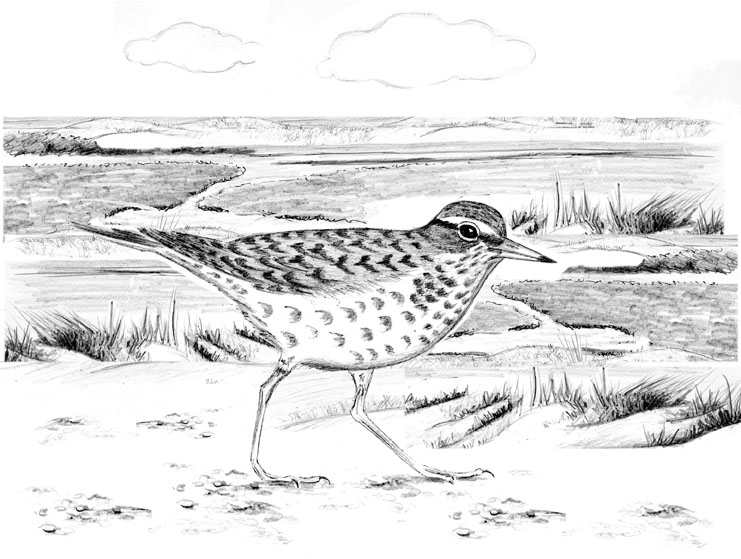
Dear Bird Folks,
Please take a look at the attached video clip of this little sandpiper I saw on my morning walk. As I got closer to the bird, it didn’t run away or fly off, it just started rocking back and forth. Any idea what was going on?
– Sarah, Chatham, MA
No, I don’t, Sarah,
I don’t know why that sandpiper was rocking back and forth and nobody else does either. The bird you saw is a Spotted Sandpiper and one of its most common behaviors is the teetering motion you just described. Typically, when the experts don’t know why a bird exhibits an odd behavior, they still have a few theories. They wouldn’t be experts if they didn’t have at least one answer or two thoughts on the subject. But this is not the case with the teetering motion of the Spotted Sandpiper. The experts refuse to even bother guessing. They just shrug and say, “Don’t know” and that’s the end of the conversation. Swell. Admitting they don’t know might get them off the hook, but it doesn’t answer your question and certainly doesn’t help me finish this column. I have 900 more words to write. I can’t simply write, “Don’t know” 450 times and expect the newspaper people to be happy. Or could I? Nah. I’d better not, they might notice.
Back in the old days (this past February), when folks from out of town could actually enter my shop and peacefully wander the aisles, one of the most commonly sought-after items was a carving or image of a sandpiper. Like salt water taffy, sandpipers remind people of their vacation on Cape Cod. But here’s the thing: salt water taffy doesn’t have any “salt water” in it, and sandpipers, at least Spotted Sandpipers, aren’t exclusively coastal birds. They can be found anywhere in the country, from the marshes of Cape Cod to freshwater bogs in Minnesota to hidden ponds in Wyoming. As long as water is around, these particular sandpipers are happy…and teetering.
Here’s something else different about Spotted Sandpipers: they tend to be loners. Most other sandpiper species migrate in huge flocks. This was a bad thing during the dark days of market hunting. Thousands of migrating shorebirds could be wiped out in a single night. Fortunately for the spotties, they aren’t into the whole flock thing. They tend to keep to themselves and thus, many of them avoided the same fate that befell their flocking cousins. Today, most sandpipers are protected and are no longer being eaten. (Now we have to teach people to stop eating diseased bats. What’s up with that?)
The Spotted Sandpiper’s most obvious field marks are its namesake spots. During the breeding season these spots are large and obvious, making it look like a Wood Thrush on stilts. The birds also fly funny. Whenever a spotty is disturbed, it will typically fly low, just barely above the water, with labored and very stiff wing beats, looking like me when I wake up in the morning. Then there is the teetering. This peculiar movement is not side-to-side, like a guy from the city on his first whale watching boat, but more like a one-person seesaw, with the backend constantly moving up and down. While the experts can’t explain the teetering, they tell us that the motion tends to increase if the bird gets “nervous.” I laughed when I read that. What do birds have to be nervous about? Is there a traffic cop following them? Are they letting a friend cut their hair because all the salons and barbershops are closed? Are they having dinner with their in-laws for the first time? Speaking of in-laws…
Like so many other things with Spotted Sandpipers, their mating habits are also out of the ordinary. They aren’t kinky or anything, but they aren’t old school either. For example, the female doesn’t like to spend her day sitting on eggs while the male floats around town on his own. So, instead, she makes the male sit on the eggs while she floats around town. (I believe the real term is polyandry, but floating around town sounds better.) In addition, the female arrives on the breeding grounds early to establish and defend a territory. Some ambitious females may even mate with several males, lay multiple clutches of eggs in different nests, and then put their feet up while the various males do most of the incubating and tending of the young. Hmm. She mates with several males, eh? Maybe that’s what all to the rocking is about.
Blue Jays are appropriately named birds. (No, I’m not changing the subject.) They are blue from the day they leave the nest until the day they move on to the big birdfeeder in the sky. The name fits them perfectly. The Spotted Sandpiper’s name fits it perfectly, too, but only half the time. Each August, at the end of the breeding season, Spotted Sandpipers grow a fresh coat of new feathers, but when the feathers have finished growing, something is missing…the spots. Spotted Sandpipers are plain in the winter and for the next six months they’ll basically be “spotless sandpipers.”
Spotted Sandpipers are interesting birds and are regularly found both here on Cape Cod and throughout the state, and the country. I wish I knew the reason for their teetering, Sarah, but so far, the birds are keeping the secret to themselves. Perhaps it’s a predator deterrent or maybe the birds are once again just trying to be different. But whatever the reason, the important thing to remember is that I just reached 900 words. Now I can put my feet up, like Mrs. Spotty.